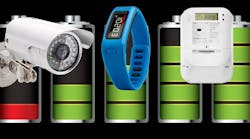This article is part of TechXchange: Power Supply Design
Download this article in PDF format.
A major focus in electronic design today is low power consumption. Low quiescent (IQ or IQ ) current plays a major part in designing battery power supplies. More and more electronic end products incorporate batteries to enable them in remote locations.
Some examples of battery-powered devices include wireless security cameras, video doorbells, and smart locks. Utility smart meters; fitness trackers, smart watches, and other wearables for health monitoring; and smartphones get their power from batteries. Many sensors and other devices in factories and other industrial facilities use batteries. Battery life an issue in all of these.
If you’re designing power supplies using modern design techniques and carefully selected ICs, long battery life becomes a reality. So, what does this discussion of low quiescent current have to do with battery longevity?
Sponsored Resources:
- Do all rails need low IQ?
- Power tips: Quiescent current and light load efficiency
- LDO basics: Quiescent current 101
Quiescent Current Defined
Quiescent current is that small amount of current needed to keep an IC or other circuit operational. The current flows even if the product may be in a sleep or shutdown mode. IQ flows even if there’s no load on the IC. Furthermore, this current can’t be eliminated or changed. That’s why it’s the key determining factor in battery life. IQ is the price you pay to keep the circuits alive even when they’re not being used.
A typical power supply for a battery-operated device probably looks like that seen in the figure. The battery feeds several dc-dc converters that, in turn, drive some low-dropout (LDO) regulators. The LDOs provide the correct regulated voltage for the various devices on each rail. Typical devices include the MCU, display, sensors and their signal conditioning, and perhaps a motor or relay. You may wonder how a linear regulator can deliver the desired efficiency and battery life in a battery-powered device.
Battery-powered devices are often complex and thus require multiple power rails to accommodate all of the diverse subsystems.
Achieving Low Quiescent Current
In a typical battery supply, the switch-mode dc-dc converter ICs produce the desired efficiency. An LDO regulator is a linear device, yet it’s remarkably efficient due to its low serial voltage drop.
LDOs are used when noise on the various power rails must be low. The secret to success with this arrangement is low IQ. Another architectural arrangement uses two cascade dc-dc converters. In some use cases, a single dc-dc converter with a special output filter is adequate. Low IQ is a primary factor in selecting each IC.
Do All Rails Need Low IQ?
In many systems, one or two voltage rails are always enabled. The selection of the ICs is critical. As you explore IC options, consider Texas Instruments’ TPS62840. This is a 60-nA IQ step-down converter. The IQ at near-100% duty cycle is only 150 nA. Input voltages can be in the 1.8- to 6.5-V range. Maximum output current is 750 mA; there are 16 predefined output voltages. This synchronous converter runs at 1.8 MHz.
The TPS62480 incorporates a unique feature: both pulse-width modulation (PWM) and pulse-frequency modulation (PFM). With normal higher loads, the device uses PWM. It seamlessly switches over to PFM during light loads to maintain high efficiency.
Now consider the LDO, a low-dropout TI TPS7A02 linear regulator. It has an input voltage range of 1.5 to 6 V and an output voltage range of 0.8 to 5 V settable in 50-mV increments. The output current capability is 200 mA. As for IQ, it is a super-low 25 nA. The shutdown IQ is an even lower of 3 nA. An enable (EN) pin is provided for control. This IC is particularly suited to battery-operated devices like wearables, medical devices, IoT nodes, smart meters, and any small battery-powered device. The LDO is available in three tiny packages: X2SON, 1 x 1 mm; DSBGA, 0.65 x 0.65 mm; and the SOT-23, 2.9 x 1.6 mm.
The combination of the dc-dc converter plus the LDO achieves not only high efficiency at a wide range of loads, but also very low IQ, making it attractive for devices that usually rest in a standby mode most of the time. And it’s the lowest noise option.
Quiescent Current and Light-Load Efficiency
During normal higher loads, a switching regulator produces its best efficiency. If the product goes into a shutdown or standby mode, the output current decreases significantly and the quiescent current becomes a significant part of the drain on the battery. Under normal load conditions, efficiency may be 80% or better. If the load drops, efficiency decreases to a range of 40% to 50%.
To mitigate this condition, you can consider the TI TPS62743 buck converter. It switches at a usual frequency of 1.2 MHz using PWM. Efficiency is about 90%. If the load drops significantly, the circuit transitions to PFM with lower switching frequencies in the vicinity of 35 kHz. This maintains an efficiency of about 80%. On top of that, the IQ is only 360 nA. TI offers a training video demonstrating this operation.
The LDO Advantage
The LDO solution to longer battery life provides the benefits of low IQ and high efficiency. That’s why it’s widely used in consumer products. However, LDOs play a big role in industrial, building, and factory applications where maximum runtime is essential.
Read more articles in TechXchange: Power Supply Design
Sponsored Resources:


